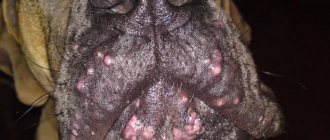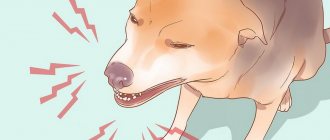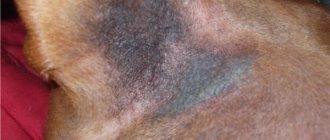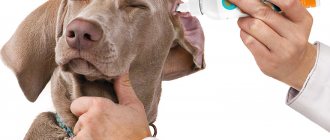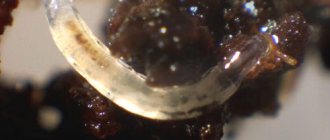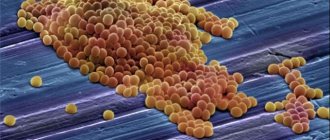Skin diseases are common in dogs and can be caused by internal or external causes. Acne, or as they are also called, pimples or blackheads, most often appear on the face, neck and nipples; the sebaceous glands are most active on these parts of the body. Due to their blockage, inflammation develops, which becomes noticeable on the skin. The most dangerous are acne, which is accompanied by profuse suppuration. Due to the addition of a secondary infection, blood poisoning may develop.
If skin rashes frequently bother your pet, the dog should be taken to the veterinarian. With timely treatment, serious complications can be avoided, preserving the health and life of the animal. The doctor will examine the nature of the changes and prescribe effective therapy.
What are comedones
Surely everyone knows about the existence of so-called “black” dots. The latter are considered one of the main cosmetic problems among people. So here it is. Comendons are almost complete analogues of “black dots”. The problem is that they can be dangerous to the animal's health.
In dogs, due to the structural features of their sebaceous glands and hair follicles, comedones in many cases are a manifestation of purulent folliculitis or even furunculosis. In this case, the bases of the hair follicles become inflamed. Since the inflammatory process is often purulent in nature, the health and even life of the dog can be in serious danger.
Diagnostic techniques
Everything is quite simple here. Since the symptoms are quite obvious, everything is usually limited to a simple external examination. The owner plays a significant role in this “action”. You must tell the specialist about the dog’s feeding conditions, changes or lack of appetite, diarrhea, vomiting, etc. If you have tried to treat your pet with something, do not be shy - if you tell the veterinarian about it in time, there will be much fewer problems later.
As a rule, specialists take a sample of pathological material in the form of a scraping and/or aspirate (pumping out the contents of the acne with a syringe)
. All this is used for further microscopic examination, or is sown on nutrient media for the purpose of growing a culture of the pathogen.
Causes of comedones on the skin of dogs
Experts today believe that the reasons for the appearance of comedones on the skin of dogs are extremely numerous:
- Injuries. The skin surface is inevitably damaged and contaminated with pathogenic/conditionally pathogenic microflora. As a rule, inflammation of staphylococcal or streptococcal etiology develops.
- Dermatitis of flea origin (as well as lice-eating and lice-eating). When there are a lot of parasites and they constantly bite the dog, it begins to itch all the time. The result is the same as in the previous case. Demodicosis and other tick-borne pathologies lead to a similar outcome.
- Autoimmune diseases, which in this case manifest themselves in the form of eosinophilic inflammation of the hair follicles and histiocytosis (as for the latter, its true causes are still unclear).
- Various fungal pathologies.
- Allergies (especially in chronic forms).
- Poor nutrition of the animal.
Therapy
What is the treatment for acanthosis in dogs? The primary form in dachshunds is incurable. In some dogs, the lesions do not progress beyond the stage of a purely cosmetic problem. If inflammation develops, the disease in its early stages may respond well to the use of medicated antimicrobial shampoos, as well as to the administration of glucocorticoids. Antihistamines and sedatives have also worked well, as they can relieve the itching that occurs from time to time. In cases where acanthosis nigricans in dogs (the symptoms of which we discussed above) tends to progress, it is necessary to resort to more “aggressive” therapy.
Unfortunately, many dogs today suffer from skin diseases. By the way, not only veterinarians, but even international associations of insurers agree with this: they report that the volume of payments to owners of purebred dogs depends 70% on these pathologies. Allergic reactions in all their manifestations are the most common, but they are not the only skin diseases in dogs.
If your pet is constantly itching, especially in warm and humid weather, then he may already be suffering from some kind of skin pathology. If your pet constantly scratches and licks its paws, face or belly, then you should immediately visit a veterinarian. In general, up to a certain point, itching may be the only symptom, so you should not consider scratching as something insignificant. Baldness and other specific signs appear much later.
If you have answers to all the questions described above, it will be much easier for your veterinarian to determine the true cause without spending a lot of time interviewing the owners (that is, you) and numerous tests.
Important!
If your dog's face is swollen or generally swollen, take him to the clinic immediately (!). This is a symptom of a potentially life-threatening allergic reaction. Don't wait until your pet dies.
Almost all dog skin diseases begin with itching.
Sometimes it is light, but sometimes the dog can fiercely scrape itself with its paws and “chew” the skin, constantly clicking its teeth. Often a dog rubs its face, as if washing itself. Similarly, when an animal licks the same place all the time, trying to get rid of the exhausting sensation.
It is important to note that in almost all cases, one way or another connected with skin pathologies, three signs are “fundamental”:
- Constant scratching.
- The desire to lick yourself around the clock.
- Areas of baldness and the appearance of some pathological formations (scratches, pimples).
And now we suggest that you familiarize yourself with the simplest diagnostic table, from which you can approximately find out the type of disease that has affected your pet.
Now let’s look at some skin diseases in dogs a little more specifically.
Primary and secondary comedones
Veterinarians distinguish between primary and secondary comedones. Let's say right away that the secondary variety occurs in almost 100% of cases. In this case, the pathology develops against the background of some other disease. For example, flea dermatitis is primary, and comedones are secondary. Accordingly, all the cases described above (with the exception of neoplasms of an autoimmune nature) refer specifically to the secondary variety.
Accordingly, the primary type is much less common. These include commandons of the following origin:
- Acne is of genetic origin. Veterinarians believe that bulldogs, boxers, Dobermans and Rottweilers are inherently predisposed to this pathology. In addition, other skin diseases are very common among them. Finally, many schnauzers have a pathology that is called “comedone syndrome.”
- Comendons of autoimmune etiology.
- Endocrine acne. They develop, as the name implies, due to disruption of the endocrine secretion glands.
Black spots under the skin: demodicosis
This disease is caused by a tick. At the first stage, the skin is covered with a red rash, but over time it becomes covered with a dark crust, which is mistaken for blackheads. As the lesion progresses, hair falls out around the lesion. Shepherd dogs, Rottweilers, Great Danes, Boxers, Collies, Shelties, and French bulldogs are prone to the disease. Risk groups include puppies under 1 year of age and pets over 10 years of age.
More about diseases caused by ticks and their treatment in the article How to remove a tick from a dog. Ticks, piroplasmosis - signs, consequences, treatment. Types of ticks.
Predisposing factors
The following predisposing factors contribute to the appearance of neoplasms:
- Incorrect, unbalanced diet.
- Poor pet hygiene. Greasy and matted wool is an excellent “reason” for the development of inflammation of the hair follicles.
- Poor living conditions. They contribute to both the deterioration of the coat and the appearance of parasites in the animal’s fur.
- Helminthic infestations. Worms themselves consume a lot of vitamins and nutrients, which causes the animal’s general condition to deteriorate, the immune system weakens, and the risk of developing autoimmune pathologies and other dangerous diseases increases.
Further development of the disease
If you don't take your dog to the vet, things will get much worse:
- Small ulcers and boils burst, the chin area is sometimes completely covered with drying pus and ichor.
- As the animal’s immunity weakens, increasingly larger papules and boils appear.
- Bursted boils and papules do not heal; large ulcers develop in their place.
- Due to pain and intoxication, the animal partially or completely loses its appetite.
List of diseases accompanied by comedones
As we have said many times, dog acne rarely grows on its own. This happens much more often if the pet is already sick with something. Here is an approximate list of diseases accompanied by comedones:
- Pathologies of the thyroid gland . In this case, primary type comedones develop.
- Comedones syndrome , or “schnauzer comedones syndrome,” which we already mentioned above.
- Sebadenitis. Hereditary autoimmune disease. We have already written that pathologies of this type can cause the growth of tumors, but in this case they appear with a 100% probability.
Diagnosis of small dark spots (dots)
All diagnostic research occurs in several stages:
- Visual examination of the skin. These lesions are characteristic only of acanthosis nigricans.
- Examination for infections, bacteria and mites (smear and scraping of damaged areas).
- Examination of the condition of the thyroid gland and adrenal glands (changes in the functioning of these organs are the main cause of the development of secondary acanthosis).
- Additional examination of the dog (if necessary) to identify the underlying disease that caused the disease.
Treatment methods for comedones in dogs
In modern veterinary medicine, the following methods of treating comedones in dogs are used:
- The simplest and most effective option is to apply medications directly to the affected areas of the skin. But for the products to work well, it is very advisable to cut off all the hair from these areas, and also get rid of the crusts of exudate. Of course, scabs should be removed by first soaking them. This is done by applying ordinary sterile oils, or 3% hydrogen peroxide. Suitable oils (sea buckthorn, almond, or refined olive) can be purchased at any nearest pharmacy. We recommend using sea buckthorn, as it not only perfectly softens the skin, but also promotes its speedy healing.
- The animal is bathed using shampoos with a keratolytic effect.
- Before the “oil” treatment, it does not hurt to remove excess sebum from the skin.
- Retinoids and other vitamins are prescribed orally to stimulate the regeneration process of the skin epithelium.
- Anti-inflammatory corticosteroids are also prescribed to stop the inflammatory process. But! Since they “impair” already weakened immunity with prolonged use, they are allowed to be used for a maximum of a couple of weeks. In addition, for some types of autoimmune pathologies, their use is strictly prohibited.
- Since comedones are often accompanied by bacterial inflammation of the skin, the dog is simultaneously prescribed broad-spectrum antibiotics.
Clinical picture
Comendons “grow” in large numbers on the chin and lips . Since these areas are covered with short and coarse hair, clinical signs quickly become apparent. Subsequently, the skin in these areas becomes inflamed, swells, and possibly (later) the formation of cicatricial adhesions. In most cases, quite severe skin itching develops, sometimes the dog scratches its face until it bleeds.
It is believed that comedones are quite common in all dog breeds. But in practice, it turns out that more than 70% of cases are diagnosed in short-haired animals. In addition, it is in them that the disease is often most severe, often (and without much delay) turning into pyoderma.
List of drugs
The list of medications we have given is approximate, and therefore in any case needs to be adjusted to the specific case of the disease:
- Benzoyl peroxide. This substance has a powerful disinfectant effect and also perfectly washes away excess sebum. The drugs Benzoyl Plus® and OxyDex®, produced on its basis, have proven themselves well. But! The concentration of the active substance should be no more than 3%!
- Isotretinoin and pure retinol are used as retinoids.
- Despite the abundance of anti-inflammatory corticosteroids, the usual drug is dexamethasone.
- Microperl Humectant has an excellent keratolytic effect.
- Antibiotics prescribed include ciprofloxacin and enrofloxacin. In severe cases, doxycycline is administered once. Apply 3% tetracycline ointment to the acne itself.
- For autoimmune diseases, immunosuppressants are prescribed. These are very specific and dangerous medications; they should be selected and prescribed exclusively by a veterinarian.
How to treat (if there is no veterinarian)
- Complete rest for a sick dog. If the individual has long hair, then it makes sense to cut off the hair around the nipple, exposing the affected part as much as possible for easy access and physiotherapeutic procedures.
- If there is no stagnation of milk, then the puppies are not weaned, applying more active and stronger ones specifically to the diseased lobes. If stagnation is detected, then the milk should be expressed by hand, and the puppies should be transferred to artificial feeding. The milk that stagnates inside literally turns sour and mixes with inflammatory secretions - not a single puppy, even the hungriest one, will suck such milk. Moreover, this can be fraught with digestive disorders in the offspring.
- Dairy products, meat and liquid soups should be completely excluded from the dog’s diet, and the amount of liquid consumed should be reduced (allow drinking only after meals). You can switch the animal to dry food during treatment.
- You should express milk only after a massage. Massage means stroking movements on the mammary gland, lightly pressing on it with your fingers so as not to cause pain to the dog. Particular attention should be paid to areas with compactions - dense areas of the gland that are clearly visible to the touch. You need to massage them until you feel them soften.
- Dogs' nipples have almost twice as many ducts as cats', so it's possible to express milk by hand (though not as easy). After massaging the entire gland, they smoothly move on to expressing, making stroking movements of the nipples from the base to the end, lightly pressing them with their fingers. In any case, it will be unpleasant for the dog, but you need to try not to cause pain (it is advisable to do everything with an assistant). There is no need to try to express all the milk from the breast; it is enough to do this until the milk lobe around the nipple collapses and becomes softer.
You can try to express milk with a homemade breast pump made from an ordinary disposable syringe (the volume of the syringe is selected according to the diameter of the nipple so that it passes freely and does not end up tightly). The piston is removed. The top of the syringe with the spout on which the needle is placed is cut off. The cut edges are aligned with fire to prevent skin injury and to ensure maximum adherence of the syringe to the skin. The nipple is inserted into the syringe, pressed tightly against the skin and the plunger is pulled - the milk will begin to be expressed a little at a time.
Before expressing, you can give your dog no-shpa at the rate of 40 mg (1 tablet) per 10 kg of weight. This will help relieve possible spasms of the milk ducts and make the procedure easier.
- If the local temperature is high (the gland is hot to the touch), cooling compresses are made - for example, you can apply a beaten and mashed chilled cabbage leaf or cool lotions from medicinal herbs: sage, chamomile, raspberry leaves, chamomile. Pour 200 ml of boiling water over 1 tbsp. any specified herb and leave for up to half an hour in a closed container. Then cool to the desired temperature, moisten gauze pads and apply to where it hurts. The top can be tied with a bandage (not too tight!). Change every time the napkin gets hot or every 2-3 hours.
- After the temperature has normalized, you can begin to make warm compresses from the same herbs as during cooling. The only difference will be in temperature - with warming compresses, the temperature of the solution should be 37-38°C. Important: it is forbidden to heat the mammary gland if there is even the slightest suspicion of purulent inflammation!
- You can use ichthyol, fir or camphor oil, which is gently rubbed into the surface of the skin of the diseased breast lobe, and then bandaged with a cellophane lining to obtain some greenhouse effect.
- Unlike cats, dogs can be given a thin iodine grid on the diseased mammary lobe - the distance between the “grids” is at least 1 cm, the frequency is once every 3-4 days. This is done with a cotton swab or a match with cotton wool wrapped around it. Lightly soak in iodine so that the stripes are slightly dark yellow and do not spread.
Caring for a dog during rehabilitation
Comprehensive care for your dog during the rehabilitation period includes:
- Once every three days, the dog is bathed using the above-mentioned keratolytic agents.
- The pet's fur is regularly combed, trimming it around the comedones.
- To prevent the animal from gnawing on damaged areas, a surgical collar is put on it.
- Three times a week, boiled sea fish, rich in polyunsaturated omega-3 fatty acids, is added to your pet’s diet. This has a beneficial effect on the speed of skin regeneration.
When is the risk of complications during self-care minimal?
You can try treating mastitis in your dog at home under the following general conditions:
- the gland is slightly swollen, there is no severe deformation;
- no increase in general body temperature;
- there is no severe pain that causes the dog to whine;
- milk can be expressed independently by hand, there are no signs of blockage of the milk ducts;
- no blood or purulent discharge;
- the inflammation did not cover the entire gland, but only its individual parts;
- You can notice improvements when using traditional medicine and home remedies during the first two days.
For the following symptoms (types) of mastitis in dogs, attempts to provide self-help are acceptable:
catarrhal mastitis:
| serous mastitis:
|
Veterinary care for inflammation of the mammary gland
- To increase the overall resistance of the body: Fosprenil
(intramuscular 0.2 ml/kg body weight 2-4 times a day for 5-7 days; it is important not to miss each subsequent injection),
Immunofan
(subcutaneous or intramuscular 1 ml/animal, once a day within 3-5 days). - Intramuscularly or subcutaneously Mastomethrin
(1-4 ml/dog, depending on size, 1-2 times/day until the symptoms go away) or
Travmatin
, if pain syndrome is severe (0.1 ml/kg body weight subcutaneously or in muscle up to 2 times a day for 3-5 days). - Antibiotics: amoxicillin 15%
(into the muscle 1 ml/10 kg of dog weight once, course 5-7 days),
ceftriaxone
(into the vein or muscle 20-40 mg/kg per day - the dose can be divided into 2 injections, course: 5 -10 days),
enrofloxacin 50
(intramuscular 1 ml/10 kg once for 5-10 days, the injection is painful, it is important not to miss a dose). - Local creams and ointments for mastitis: “Zorka” cream
(smear the nipples 1-2 times a day after washing),
DE cream-emulsion
(apply a very thin layer 2-3 times a day to the affected lobe of the gland, without touching the nipple; course up to 1 week),
De-Long cream-emulsion
(applied to the inflamed mammary lobe, covering healthy areas without signs of damage and compaction up to 3 times a day for 5-7 days; in special cases, injected directly into the mammary gland through nipple using a milk catheter for dogs),
Phytoelita Antiseptic cream-balm
(applied to areas of inflammation and seals under a bandage once a day, changing the bandage every day, and after 3-5 days - every other day. Course - 2 weeks). - Short novocaine blockades. Novocaine 0.5%
is injected at a dose of 5-20 ml (depending on the size of the dog) into the space between the affected mammary gland and the peritoneal wall. If necessary, repeat the procedure after 1, 2 or 3 days. - Surgical treatment of mastitis in dogs is indicated in especially severe cases. Abscesses are opened, the purulent wound surface is cleaned, and drains are installed to drain the inflammatory fluid. In severe cases, the gland is removed (mastectomy), either part or all.
